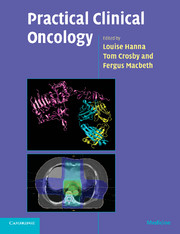Book contents
- Frontmatter
- Contents
- List of contributors
- Preface
- Acknowledgements
- Abbreviations
- 1 Practical issues in cytotoxic chemotherapy usage
- 2 Biological treatments in cancer
- 3 Hormones in cancer
- 4 Radiotherapy planning
- 5 Research in cancer
- 6 Oncological emergencies
- 7 Palliative care
- 8 Head and neck
- 9 Oesophagus
- 10 Stomach
- 11 Liver, gallbladder and biliary tract
- 12 Exocrine pancreas
- 13 Colon and rectum
- 14 Anus
- 15 Gastrointestinal stromal tumours
- 16 Breast
- 17 Kidney
- 18 Bladder
- 19 Prostate
- 20 Testis
- 21 Penis
- 22 Ovary
- 23 Body of the uterus
- 24 Cervix
- 25 Vagina
- 26 Vulva
- 27 Gestational trophoblast tumours
- 28 Lung
- 29 Mesothelioma
- 30 Soft tissue and bone tumours in adults
- 31 The lymphomas and myeloma
- 32 Central nervous system
- 33 Skin cancer other than melanoma
- 34 Melanoma
- 35 Thyroid
- 36 Neuroendocrine tumours
- 37 Cancer in children
- 38 Cancer of unknown primary
- 39 The use of radiotherapy in the treatment of benign conditions
- Multiple choice questions
- Multiple choice answers
- Index
- References
39 - The use of radiotherapy in the treatment of benign conditions
Published online by Cambridge University Press: 23 December 2009
- Frontmatter
- Contents
- List of contributors
- Preface
- Acknowledgements
- Abbreviations
- 1 Practical issues in cytotoxic chemotherapy usage
- 2 Biological treatments in cancer
- 3 Hormones in cancer
- 4 Radiotherapy planning
- 5 Research in cancer
- 6 Oncological emergencies
- 7 Palliative care
- 8 Head and neck
- 9 Oesophagus
- 10 Stomach
- 11 Liver, gallbladder and biliary tract
- 12 Exocrine pancreas
- 13 Colon and rectum
- 14 Anus
- 15 Gastrointestinal stromal tumours
- 16 Breast
- 17 Kidney
- 18 Bladder
- 19 Prostate
- 20 Testis
- 21 Penis
- 22 Ovary
- 23 Body of the uterus
- 24 Cervix
- 25 Vagina
- 26 Vulva
- 27 Gestational trophoblast tumours
- 28 Lung
- 29 Mesothelioma
- 30 Soft tissue and bone tumours in adults
- 31 The lymphomas and myeloma
- 32 Central nervous system
- 33 Skin cancer other than melanoma
- 34 Melanoma
- 35 Thyroid
- 36 Neuroendocrine tumours
- 37 Cancer in children
- 38 Cancer of unknown primary
- 39 The use of radiotherapy in the treatment of benign conditions
- Multiple choice questions
- Multiple choice answers
- Index
- References
Summary
Introduction
Early in the past century, radiation therapy was applied to a whole range of non-malignant conditions largely because of its immunosuppressive and antiproliferative properties. With the evidence of its potential to cause serious and irreversible long-term side effects and the development of more effective medical anti-inflammatory therapies, the place of radiotherapy in the treatment of benign conditions has declined.
Although described as benign, many non-malignant conditions can have grave consequences for the patient in terms of symptoms and quality of life. In certain clinical conditions and in carefully selected patients, low-dose radiation therapy should be considered, provided that the patient is adequately informed of the potential risks and benefits. All patients should be managed in conjunction with other specialists to ensure that all appropriate therapeutic options have been considered.
There is a lack of published data, but overall, the risks are small as long as low doses are combined with careful technique. Sensitive normal tissues such as the eye, gonads, thyroid and bone marrow should be avoided, and radiation therapy in general should not be administered to children and young adults. Court-Brown and Doll (1965) demonstrated a 9.5-fold increase in leukaemia in patients with ankylosing spondylitis who were treated with radiotherapy. The risks were greater when larger radiation fields and higher doses were involved. There is also documented evidence of an increased incidence of thyroid cancer and soft tissue or bone sarcoma.
- Type
- Chapter
- Information
- Practical Clinical Oncology , pp. 449 - 452Publisher: Cambridge University PressPrint publication year: 2008
References
- 1
- Cited by



